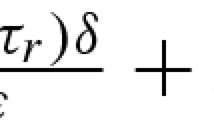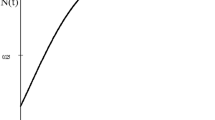Abstract
Consider an economy described by two states. The first state describes a private stocksubject to a firm's (or a consumer's) control, while the second state captures market interactionsand is exogenous data to the individual firm. Considering rational expectations, amarket equilibrium can be derived. This set‐up is typical, in particular for the recentlyinvestigated new endogenous growth models. In contrast to the market outcome, planningattempts to internalise this externality. In both cases, the policies ‐ either the optimal intertemporalpolicy of competitive firms exposed to this externality, or the social optimum ‐are characterised by a two‐dimensional plane. Thus, complex solutions in particular limitcycles are possible. This paper compares the conditions of stability and, in particular, theconditions for limit cycles under these two different institutional set‐ups, when the externalityis or is not properly internalised. This comparison is first theoretical and then applied to adeliberately simple economic example: firms accumulate a capital stock (e.g., sewage treatment,energy saving technologies) involving convex investment costs and this stock lowersemissions (or kinds of waste) that add to a stock of pollution (e.g. global warming, pollutionof water and soil, etc.).
Similar content being viewed by others
References
J. Benhabib and K. Nishimura, The Hopf bifurcation and the existence and stability of closed orbits in multi-sector models of economic growth, Journal of Economic Theory 21(1979)421-444.
J. Benhabib and R. Perli, Uniqueness and indeterminacy: On the dynamics of endogenous growth, Journal of Economic Theory 63(1994)113-142.
J. Benhabib and A. Rustichini, Equilibrium cycling with small discounting, Journal of Economic Theory 52(1990)423-432.
A.L. Bovenberg and S. Smulders, Environmental quality and pollution-augmenting technological change in a two-sector endogenous growth model, Journal of Public Economics 57(1995)3369-3391.
P. Cartigny and A. Venditti, Turnpike theory. Some new results on the saddle point property of equilibria and on the existence of endogenous cycles, Journal of Economic Dynamics and Control 18(1994)957-974.
C.W. Clark, F.H. Clarke and G.R. Munro, The optimal exploitation of renewable resource stocks: Problems of irreversible investments, Econometrica 47(1979)25-47.
E. Dockner, Local stability analysis in optimal control problems with two state variables, in: Optimal Control Theory and Economic Analysis 2, ed. G. Feichtinger, North Holland, Amsterdam, 1985, pp. 89-103.
E. Dockner and G. Feichtinger, On the optimality of limit cycles in dynamic economic systems, Journal of Economics 53(1991)31-50.
E. Dockner and G. Feichtinger, Cyclical consumption patterns and rational addiction, American Economic Review 83(1993)256-263.
G. Feichtinger, A. Novak and F. Wirl, Limit cycles in intertemporal adjustment models — theory and applications, Journal of Economic Dynamics and Control 18(1994)353-380.
G. Feichtinger and G. Sorger, Optimal oscillations in control models: How can constant demand lead to cyclical production?, Operations Research Letters 5(1986)277-281.
A. Greiner and H. Hanusch, Schumpeter's circular flow, learning by doing and cyclical growth, Evolutionary Economics 4(1994)261-271.
A. Greiner and W. Semmler, Multiple steady states, indeterminacy, and cycles in a basic model of endogenous growth, Journal of Economics 63(1996)79-99.
J. Guckenheimer and P. Holmes, Nonlinear Oscillations, Dynamical Systems, and Bifurcation of Vector Fields, Springer, New York, 1983.
R.F. Hartl, A simple proof of the monotonicity of the state trajectories in autonomous control problems, Journal of Economic Theory 41(1987)211-215.
A.I. Khibnik, Yu.A. Kuznetsov, V.V. Levitin and E.V. Nikolaev, Interactive LOCal BIFurcation Analyzer, Manual, CAN, Amsterdam, 1992.
R.E. Lucas, Jr., On the mechanics of economic development, Journal of Monetary Economics 22(1988)3-42.
K. Nishimura and H. Takahashi, Factor intensity and hopf bifurcations, in: Dynamic Economic Models and Optimal Control, ed. G. Feichtinger, North Holland, Amsterdam, 1992, pp. 135-162.
K. Phillips, The Politics of Rich and Poor, Random House, 1990.
K.R. Popper, Kepler: Seine Metaphysik des Sonnessystems und seine empirische Kritik (1986), reprinted in: Alles Leben ist Problemlösen, Piper, München/ Zürich, 1995, pp. 145-152.
P.M. Romer, Endogenous technological change, Journal of Political Economy 98(1990)71-102.
H.E. Ryder, Jr. and G.M. Heal, Optimal growth with intertemporally dependent preferences, Review of Economic Studies 40(1973)1-31.
B. Saffran, Recommendations for further reading, Journal of Economic Perspectives 11(1997)179-186.
M. Sieveking and W. Semmler, The present value of resources with large discount rates, Applied Mathematics and Optimization 35(1997)283-309.
O. Tahvonen and C. Withagen, Optimality of irreversible pollution accumulation, Journal of Economic Dynamics and Control 20(1996)1775-1795.
F. Wirl, Cyclical strategies in two-dimensional optimal control models: Necessary conditions and existence, Annals of Operations Research 37(1992)345-356.
F. Wirl, The cyclical exploitation of renewable resource stocks may be optimal, Journal of Environmental Economics and Management 29(1995)252-261.
F. Wirl, Pathways to Hopf bifurcations in dynamic, continuous time optimization problems, Journal of Optimization Theory and Applications 91(1996)299-320.
F. Wirl, Stability and limit cycles in one-dimensional dynamic optimizations of competitive agents with a market externality, Journal of Evolutionary Economics 7(1997)73-89.
C. Withagen, Pollution, abatement and balanced growth, Environmental and Resource Economics 5(1995)1-8.
Rights and permissions
About this article
Cite this article
Wirl, F. Dynamic externalities:Comparing conditions for Hopf bifurcationunder laissez‐faire and planning. Annals of Operations Research 89, 177–194 (1999). https://doi.org/10.1023/A:1018971506197
Issue Date:
DOI: https://doi.org/10.1023/A:1018971506197




